|
South Carolina C.S.A.
|
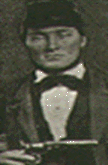
|
Colors of the Sixteenth South Carolina |

|
South Carolina C.S.A. |
|
Company G Standard Bearer Atlanta |
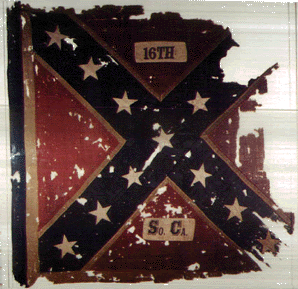
|
|
Did the Sixteenth Lose a Stand of Colors? For many years people, including the author, wondered if the Sixteenth lost her colors and if so where? While the author has not done exhaustive work on the issue, it is his belief that they did not. The evidence for this position is as follows. The source of most reports of a "lost" set of 16th colors is the report issued when the flags were returned to the southern states in 1905. Writing to Governor Heyward, Secretary of War Taft said in March of 1905. "I have the honor to advise you that, under the authority conferred upon the Secretary of War by the joint resolution of Congress approved February 28, 1905, entitled 'A Joint Resolution' to return to the proper authorities certain Union and Confederate battle flags that were in the custody of the War Department at the time of the approval of said joint resolution and that could be identified as belonging to your State or as having been borne by military organizations thereof." "A few of the flags that were described in Executive document No. 163, House of Representative, Fiftieth Congress cannot now be identified. Their numbers or distinguishing marks have been lost and a few of the flags that could not be identified in 1868 have since been identified and are now returned to the states to which the organization which bore them belonged." In the description that follows is one flag that is most often associated with capture from the Greenville Regiment. The description is, The flag of the 16th Regiment Infantry, Flag of the Sixteenth South Carolina Volunteers, was captured during the engagement of April 7,1865, at Five Forks, Va. The Medal of Honor citations yield the following information:
SCOTT, JOHN WALLACE Eleven stands of Confederate Colors were captured at Five Forks and the Richmond-Petersburg line was broken. Tragic as this was, the Sixteenth was no where near the event. The Sixteenth was never in the East. Therefore, it was physically impossible for the unit to have lost its colors in that theater of operations. The methods of marking and collecting captured flags and the battle damage to the flags almost guaranteed incorrect identification. The captured flag book, cited below, notes some of the problems that Louisiana had in 1905, so one can imagine the issues that come to the fore almost one hundred years later. However, the same book shows a painting of captured flag 277 that precludes any confusion between that flag and the B.B. Smith flag. Flag 277 is shown to be an unmarked generic set of standard colors. The B.B. Smith flag is clearly marked 16th and So. Ca. In recent news, rumor has it that Flag 277 has surfaced in private hands in Virginia at a public event. It has been stated that research reveals the flag was captured from a North Carolina, not a South Carolina unit. This would eliminate any possibility of the flag having been taken from Shank Evansí Brigade. What follows is the history of the B.B. Smith flag and its twin, the flag of the Twenty-four South Carolina. The time line on the flags from presentation to 1883 is now complete. All that remains is to locate the information concerning the transfer of the flags to the U.D.C. These fine ladies were, for many years, the caretakers of what has become the Confederate Relic Room. Where could the Sixteenth have lost the colors and what did the veterans of the unit say about those battles? The first choice of everyone for a battle that the Sixteenth would have lost a set of colors seems to be Franklin. As the Sixteenth was hard hit in the action the choice is very logical. However, the men of the 16th are clear in the 1883 article shown in the Aftermath section that the flag was not lost at Franklin. They also state the flag continues with them to the end of the war. Since B.B. Smith returns this flag in 1883 with no mention of a capture, this flag seems an unlikely candidate for capture speculation. No captured flags were in Confederate hands in 1883. A handful may have been returned by individuals but Smith clearly states in his letter to the men that he has had sole possession of both flags. Smith is clear, he brought the flags of the Twenty-fourth and Sixteenth home after the surrender and he kept them from 1865 until their return to the men in 1878 (Twenty-fourth) and 1883 (Sixteenth). (See a History of Edgefield County, Chapman, J.A., for the account of the return of the colors of the Twenty-Fourth) In addition to this, the loss and capture of colors at Franklin was the source of some investigation by both armies in the aftermath of the battle. Hood lists no South Carolina flags in his report and no claim is made by Union Army sources. These reports are not definitive, given that Cheathamís report is missing. This issue was examined in a recent work on the battle flags of the Army of Tennessee, and no mention was made of a South Carolina flag either captured or lost at Franklin in that work. The author in his Appendix, in the section entitled, "Losses of Confederate Colors at the battle of Franklin" does not mention the colors of the Sixteen or any South Carolina unit. However, it is certain that the Confederates lost more colors than they admitted and the Union captured fewer than they claimed. There are other places that the Sixteenth could have lost her colors. The most likely would seem to be at either Missionary Ridge or in The Battle of Atlanta when General Walker was killed near her front. Since the Battle of Atlanta is mentioned as the place where this flag was first hit by artillery in the 1883 article, it can be safely eliminated. The retreat from Nashville is also suspect, although the survivors are clear that the Franklin flag was with them until the end of the war. Missionary Ridge seems unlikely because The Gist Brigade was one of the units to retire in good order. The most likely place seems to be when about seventy men of the Sixteenth and most of Fergusonís Battery were captured in that retreat. The men of the Gist Brigade were acting as the rear guard of the army as it retreated from Missionary Ridge and Gist was commended both for his conduct and the conduct of his brigade. I can locate no Union claim of a capture or Confederate claim of a loss, that fits the Sixteenth Colors, associated with this action. Further because the two colors, the Twenty-fourth and Sixteenth, match as to construction and marking it seems unlikely that either was replaced after their issue by General Beauregard on the coast of South Carolina. (Enlisted for the War, Jones, Eugene quoted in the Gist Brigade Section of this website.) The logical starting place for additional inquiry would seem to be the Confederate Relic Room in Columbia, which possesses the flag that is most, identified with the Sixteenth. A through and complete search of all the Relic Room records might reveal the location of the second flag (Captured flag 277) that was returned in 1905. Rumor has it that flag 277 is in private hands in Virginia, if this is so, then it would difficult for the relic room to produce it. An exhaustive look at the letters of Ellison Capers and B.B. Smith should also be undertaken. Though that might appear unnecessary today, it probably appeared unnecessary to document the flags when they came to the U.D.C. from Bishop Capers and the veteranís association in the early part of this century. The closest either of these flags seems to have come to capture was the odd incident Eugene Smith relates in his book concerning the 24th flag and General Ellison Caperís baby. Individual exchanges of flags, letters, personal items, swords and weapons were common in the post war era. The flag of the 97th Ohio was certainly returned in 1885 by General Capers to the men who carried it into the caldron that was Franklin. Jones in his book, that is an exhaustive study of the Twenty-fourth, certainly believes that Smith brought the colors home. All physical evidence supports that position. The B.B. Smith Sixteenth flag shows no trace of capture marking and does not match the painting found in the Book of Captured Flags. There is no reason to believe that the flag in the possession of the relic room is anything but the B.B. Smith flag or that a "Greenville County Sixteenth Flag" was captured by Union forces during or after the war.
I await additional information on the subject. If you have information, especially accounts that might indicate a loss, capture of colors, or clarify the 1905 return, or the presentation of the flag to the U.D.C., probably between 1890 and 1910, I would appreciate being made aware of them and I am certain the museum of the Sixteenth in Greenville would appreciate that information, as well.
|
|
|

|
|
Presented to the Confederate Veterans, June 14,1905 Reprinted by Rank and File Publications ISBN#0-9638993-4-1 Flags identified in that publication in descending order, The 27th, The 8th, and the 16th South Carolina (Captured flag 277). Even a cursory viewing shows it not to be the B.B. Smith flag pictured at the top of the page. |
|
Posted Thanksgiving, 1999 The following is entitled "Memorial Day at Mount Lebanon." It deals with a Memorial Day Service at Mount Lebanon Church prior to 1910. The address clearly placed the flag of the Sixteenth South Carolina in Columbia at that date. It was probably in the care of the U.D.C. at this time. Also of interest is the other flag mentioned. This is probably the flag of the Fourth South Carolina but additional details would be needed to confirm this. "In this graveyard adjoining our church are buried some old soldiers who fought under the Stars and Bars of the South Confederacy and all around are those battle-scarred veterans who risked their lives and shed their blood to uphold the cause of our Southern land. As the sailor in after years delights to look upon the vessel which has carried him over the stormy oceans so also does the old soldier take pleasure in looking upon the flag under which they fought and under which their comrades fell and under which they died. It would have been a pleasure no doubt to these of the Sixteenth So.Ca. to see their old banner but it was far away in Columbia and here is one which while it may not be the flag of your regiment is one which was often on the battle field and in the thickest of the fight. From Fort Sumter in Charleston it went with the first regiment of S. Ca. that volunteered to the Battle fields of Virginia and was held aloft at Manassas and at Bulls Run." A Second More Mysterious Article about the Flags. August 1, 1888 "On the stand were two Confederate battleflags, one presented to the Fourth South Carolina Volunteers at Leesburg, Virginia, in June of 1861, and now in tatters; the second flag belonged to Anderson's Company of the Fourth Regiment, known as the Confederate Guard flag, under which the troops of Colonel McCullough fought. This flag was used in the first hour of the fight at First Manassas." Was there a flag, a company flag, that was used by the Fourth and after First Manassas (7/2/61) until the presentation of the battleflag of the Sixteenth (4/20/63), used by the Sixteenth... is this the flag that survives in private hands, always more questions. The battleflag of the Sixteenth was in Greenville County at the time with Colonel McCullough, so is this the flag that the writer means. One wonders if when Captain Monroe brought the small group from Laurens and Anderson County to Company E if they brought this flag with them? So many questions? To make it even more complex, Anderson's Company, Company J, The Confederate Guard, Fourth South Carolina was from Anderson County. E&M |
|
The Struggles of the Gallant 24th Regiment, South Carolina Volunteers, Infantry, 1861-65 Eugene W. Jones Jr. "On Monday, April 20, 1863, General Beauregard reviewed two brigades, commanded by Gist on James Island. General T.L. Clingman commanded one of the brigades and Colonel Stevens the other. Capers commanded the 24th. Afterwards, Beauregard presented each of the regiments with a battle flag. The flag was the Starry Cross or the St. Andrew's Cross, also known as 'The Beauregard Flag.' The 24th would carry these colors until the end of the war." Enlisted for the War, Jones The men at Greensboro, who feared they would have to surrender them, cut up the colors of the 24th. They reside today in the Confederate Relic Room with the colors of the Sixteenth. Col. B.B. Smith hid both flags at the end of the war and Smith returned the Twenty-Fourth Colors to the vets in the late 1870's. These colors both carry identical numerical designations and the square cut out at the bottom of the 24th would have supported the So. Ca. designation. Both are Charleston Depot colors and neither carries any mark that would show them having been captured. |
|
A final note concerning the flag in general and this flag in particular and our attitudes today. Mr. Joseph McKinney is closely associated with the B.B. Smith flag. Many will recall the sixteen-year-old boy who went into the works at Franklin and helped to save the flag and captured a number of Union soldiers. This was Mr. McKinney. In an article from the Enterprise of August 15, 1883, we learn that he carried the colors at both Jonesboro and Franklin. In later years, Mr. McKinney would become an official of Greenville County and at that time he brought this flag, the B.B. Smith flag, back to the Greenville County Courthouse and flew the old banner there for a number of days. Mr. McKinney never forgot who he was or the pride he felt in where he was from... may we all strive do the same. Bibliography: CHAPMAN, J.A.: History of Edgefield County. EUGENE JONES: Enlisted For the War, The Struggles of the Gallant 24th Regiment, South Carolina Volunteer, Infantry, 1861-65. The best South Carolina Regimental History ever written. Full and complete rosters. The Returned Battle Flags; Presented to the Confederate Veterans, June 14,1905; Reprinted by Rank and File Publications; ISBN#0-9638993-4-1 For more about the 24th and her colors. |
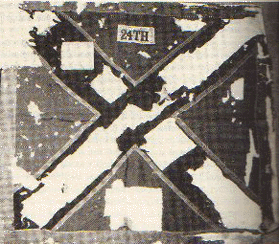 |
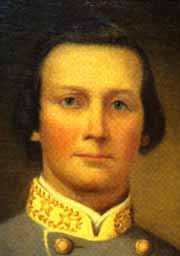
|
|
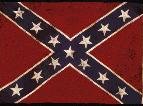
|